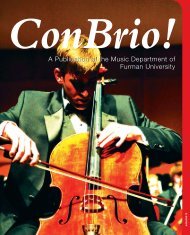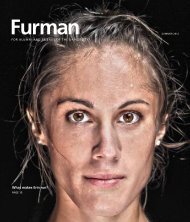Download - Furman University
Download - Furman University
Download - Furman University
- No tags were found...
You also want an ePaper? Increase the reach of your titles
YUMPU automatically turns print PDFs into web optimized ePapers that Google loves.
Images of Cleveland’s historycourtesy Michael SchwartzLibrary, Special Collections,Cleveland State <strong>University</strong>.DigitalconnectionsFrom left: Vendor Rose Thomas sells her beets at the West Side Market, 1947; Cuyahoga River fire of 1952; aviatrix Blanche Noyes on her way to Santa Monica for Air Races, 1929.in 2003, when they were newly minted academicson the job market. Both ended up in Ohio,Feight at Shawnee State in the south and Southerat Cleveland State in the north.Over the years they built a collegial relationshipbut maintained separate professional tracks.Then Feight got wind of Cleveland Historical,a project that Souther was designing with hiscolleague, Mark Tebeau.Cleveland Historical grew out of an initiativeto revitalize Euclid Avenue, a once-glamorousstreet known as “Millionaire’s Row” that haddeclined during the 20th century. In 2004Cleveland Public Art, a nonprofit civic group,invited Tebeau and Souther, who co-direct theCenter for Public History + Digital Humanitiesat Cleveland State, to develop a projectcommemorating the street’s historic significance.It would be part of a larger urban renewal projectled by the Greater Cleveland Regional TransitAuthority. Tebeau and Souther soon developeda plan to incorporate local history into the streetscapethrough interactive touchscreen kiosks.They worked on the project for three years,adding hundreds of photos and audio clipsto 19 kiosks and highlighting more than 60historical sites and figures. The kiosks werestrategically positioned at bus stops alonga new rapid transit corridor, allowing passengersto peruse the collection of stories and imageswhile waiting for their buses.Tebeau and Souther enlisted their studentsto help them research Euclid Avenue and conductoral histories with local residents. The students,in turn, had a chance to see their work displayedin public.By all measures, the project was a success.But Souther and Tebeau began to envisionsomething bigger.“We started thinking that only a smallnumber of people would ever see [the kiosks],”says Souther. They sought a means “to engagea broader community . . . to really empower thepublic to tell the region’s history.” They decidedto merge their collection of local history storieswith a rapidly growing form of communication— mobile phones.“At that point apps were not really thatwidely used,” Souther says. “The iPhonewas not all that old. We really were chartinga new kind of mobile app.”Souther and Tebeau introduced the ClevelandHistorical app and its accompanying website,clevelandhistorical.org, in 2010. The websiteaverages 5,000 unique visitors per month andthe app, which is free, has been downloadedmore than 11,000 times. The app contains informationon more than 400 local sites and figures.The app offers several advantages over theEuclid Avenue kiosks. It includes far morecontent, covering a much broader swath ofthe city. Some of the sites now feature minidocumentariescomposed of historical footageand expert commentary. Partnerships withschools, neighborhood associations and othercommunity groups have allowed more peopleto share their histories through the app. Finally,and most importantly, you don’t have to stopreading the stories when you get on your bus.SPOKANE HISTORICAL. Explore KentuckyHistory. New Orleans Historical. ExploreBaltimore Heritage. These are just a handfulof the apps that now run on Curatescape, themobile app platform developed by Souther,Tebeau, and several partners to “curate thelandscape.” Each app is slightly different,but they all have a common feel thanks tothe carefully planned design of Curatescape.As soon as he heard about ClevelandHistorical, Feight was hooked on the idea.He licensed a copy of Curatescape and namedhis app Scioto Historical after the river valleyhe now calls home.“[This project] really emphasizes the image,”says Feight, who snaps photos everywhere hegoes. He often takes along historical photos andpractices the art of “rephotography” — recreatingthe exact angle of an old photo with a newcamera to provide a visual record of change.At Bear Lake, the small reservoir where hewished for a machete, Feight scrambled downto the lake bank and up through the trees,trying to recreate photos taken in the 1930sjust after the reservoir was built by the CivilianConservation Corps (CCC).“Really what you’re doing is illustratinga story,” says Feight, who organizes his storiesinto historical tours. “What’s most importantMay Day protests for civil rights and labor reform, 1930; Frank Yankovic Band, 1962.about a tour is that it have a narrative. The firststep is figuring out what the narrative is.”Scioto Historical was scheduled to go publicthis spring with tours on a variety of subjects,including the pioneer days in southern Ohio,local ties to abolitionism and the UndergroundRailroad, Morgan’s Raid, and the work of theCCC in Shawnee State Forest. Future plansinclude a tour about the Adena and Hopewellearthworks and a tour to celebrate the bicentennialof the city of Portsmouth.“A tour is like a chapter in a book,” saysFeight. “It’s not like an encyclopedia.” The point,he explains, is not to be comprehensive but“thoughtfully selective. If you find a significantstory, then you’ve got a location.” And once youhave a location, you can find images or, ifnecessary, create new images.In addition to including his own photos onthe app, Feight commissioned six oil paintingsby Herb Roe, a Portsmouth native who contributedto nearly half a mile of historical muralson the city’s floodwalls. “It’s a new golden agefor illustrated history,” says Feight.SOUTHER AND FEIGHT have faced a commonbias in the academic world against historyprojects that involve the general public. Bothagree there’s a need to strike a careful balancebetween allowing broad participation in theprocess of documenting history and guardingagainst inaccuracies.“Yes, we edit,” says Souther. “Yes, we checkfacts, up to a point.” But not so obsessively thatstories are locked up forever in dusty archives.“Let the public create content,” he urges.“One of the biggest impediments to doing publichistory in universities is the fear of giving upsome control. That’s one of the things we’vedone the best, I think — giving up some control,taking some risks.”Feight notes that some historians believe oralhistories contain distortions because of the limitsof human memory. “That’s true,” he concedes.“But I really believe you can say the same ofall the sources. The key is to be skeptical of allsources. . . . Differing stories interest me. It’s OKto have different accounts.”Perhaps it’s not surprising that Souther andFeight, two products of a liberal arts education,are quick to embrace a bit of uncertainty inexchange for a broader picture of the world.“We find that for many people there is a Truthwith a capital T. History is about facts and datesand it’s not open to interpretation,” says Souther.“We take the view that history is all about theinterpretation. We’re not giving someonea Truth.” |F|See clevelandhistorical.org and sciotohistorical.org.The author, a 2008 graduate, lives in Madison, Wis.,where she works as a technical writer for Epic,a healthcare software company.FURMAN STUDENTS and faculty areincreasingly involved in collaborativeprojects in which they use digital toolsto share their findings with the widerworld. A few examples:Historyengine.org: In collaborationwith the <strong>University</strong> of Richmond, studentsresearch a topic, then write a short articlethat is published on the History Enginewebsite. The project allows students totake ownership of a small piece of history.Says history professor Lloyd Benson,“<strong>Furman</strong> students are able to bring to lightdocuments that might not otherwise catchthe attention of scholars. They can becomethe expert on a single document.”Katrinamem.org: Diane Boydand Mike Winiski of <strong>Furman</strong>’s Centerfor Teaching and Learning worked withDrew Woten ’12 to create a site featuringan interactive map of Hurricane Katrinacommemorations in New Orleans. Theproject grew out of Boyd’s May Experiencecourse in New Orleans, where Woten andhis classmates worked alongside localresidents to rebuild areas devastatedby the storm.Folio.furman.edu: Through the<strong>Furman</strong> Folio project, classics faculty andstudents work to preserve ancient historyby sharing high-quality digital images ofrare texts, accompanied by contextualinformation to offer a fuller understandingof the featured works. Says ChristopherBlackwell, Louis G. Forgione <strong>University</strong>Professor of Classics, “This is a projectentirely in keeping with the best traditionsof the discipline.”Turn the page to learn how another<strong>Furman</strong> program is expanding its reachby going mobile.12 FURMAN | SPRING 2013FURMAN | SPRING 2013 13



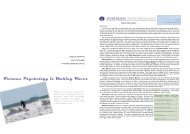
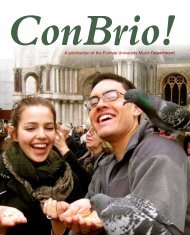
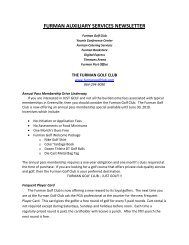
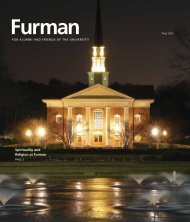

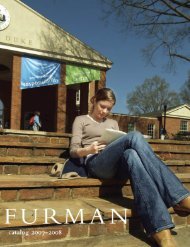
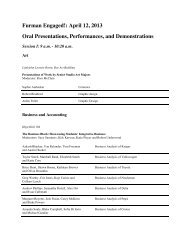

![Guidelines [PDF] - Furman University](https://img.yumpu.com/43814619/1/190x245/guidelines-pdf-furman-university.jpg?quality=85)
